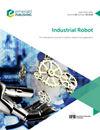A novel dual-stage shape memory alloy actuated gripper
IF 2.5
4区 计算机科学
Q3 ENGINEERING, INDUSTRIAL
Industrial Robot-The International Journal of Robotics Research and Application
Pub Date : 2022-12-05
DOI:10.1108/ir-04-2022-0114
引用次数: 1
Abstract
Purpose The paper aims to propose a novel dual-stage shape memory alloy (SMA) actuated gripper (DAG), of which the grasp performance is improved through primary and secondary actuation. Design/methodology/approach This paper presents a method of integrating the design of dual-stage actuation modules based on the SMA bias actuation principle to enhance the grasping shape adaptability and force modulation of a DAG. The actuation angle range and grasping performance of the DAG are investigated by thermomechanical analysis and the finite element method based numerical simulation. Findings The results of present experiments and simulations indicate that the actuation angle scope of the DAG is about 20° under no load, which enables the grasping space occupied by an object in the DAG from 60 mm to 120 mm. The grasping force adjusted by changing the input power of the primary main actuation module and secondary fine-tuning actuation module can reach a maximum of 2 N, which is capable of grasping objects of various sizes, weights, shapes, etc. Originality/value The contribution of this paper is to design a DAG based on SMA, and establish the solution methods for the primary main actuation module and secondary fine-tuning actuation module, respectively. It lays a foundation for the research of lightweight and intelligent robotic grippers.一种新型双级形状记忆合金驱动夹持器
目的提出一种新型的双级形状记忆合金(SMA)驱动抓取器(DAG),该抓取器通过一次驱动和二次驱动来提高抓取性能。本文提出了一种基于SMA偏置驱动原理的双级驱动模块集成设计方法,以提高DAG的抓握形状适应性和力调制性。采用热力分析和有限元数值模拟的方法,研究了DAG的驱动角度范围和抓取性能。实验和仿真结果表明,在无负载情况下,DAG的驱动角范围约为20°,可使DAG中物体所占的抓取空间从60 mm增加到120 mm。通过改变一次主驱动模块和二次微调驱动模块的输入功率来调整抓取力,最大可达到2 N,能够抓取各种尺寸、重量、形状等物体。本文的贡献在于设计了基于SMA的DAG,并分别建立了一次主驱动模块和二次微调驱动模块的求解方法。为研究轻量化智能机械手奠定了基础。
本文章由计算机程序翻译,如有差异,请以英文原文为准。
求助全文
约1分钟内获得全文
求助全文
来源期刊
CiteScore
4.50
自引率
16.70%
发文量
86
审稿时长
5.7 months
期刊介绍:
Industrial Robot publishes peer reviewed research articles, technology reviews and specially commissioned case studies. Each issue includes high quality content covering all aspects of robotic technology, and reflecting the most interesting and strategically important research and development activities from around the world.
The journal’s policy of not publishing work that has only been tested in simulation means that only the very best and most practical research articles are included. This ensures that the material that is published has real relevance and value for commercial manufacturing and research organizations. Industrial Robot''s coverage includes, but is not restricted to:
Automatic assembly
Flexible manufacturing
Programming optimisation
Simulation and offline programming
Service robots
Autonomous robots
Swarm intelligence
Humanoid robots
Prosthetics and exoskeletons
Machine intelligence
Military robots
Underwater and aerial robots
Cooperative robots
Flexible grippers and tactile sensing
Robot vision
Teleoperation
Mobile robots
Search and rescue robots
Robot welding
Collision avoidance
Robotic machining
Surgical robots
Call for Papers 2020
AI for Autonomous Unmanned Systems
Agricultural Robot
Brain-Computer Interfaces for Human-Robot Interaction
Cooperative Robots
Robots for Environmental Monitoring
Rehabilitation Robots
Wearable Robotics/Exoskeletons.

 求助内容:
求助内容: 应助结果提醒方式:
应助结果提醒方式:


